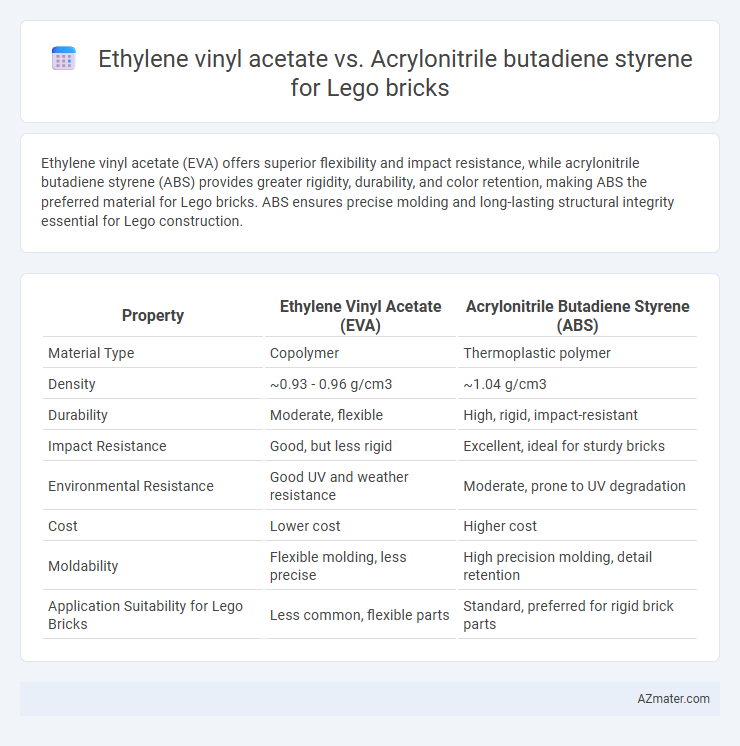Ethylene vinyl acetate (EVA) offers superior flexibility and impact resistance, while acrylonitrile butadiene styrene (ABS) provides greater rigidity, durability, and color retention, making ABS the preferred material for Lego bricks. ABS ensures precise molding and long-lasting structural integrity essential for Lego construction.
Table of Comparison
| Property | Ethylene Vinyl Acetate (EVA) | Acrylonitrile Butadiene Styrene (ABS) |
|---|---|---|
| Material Type | Copolymer | Thermoplastic polymer |
| Density | ~0.93 - 0.96 g/cm3 | ~1.04 g/cm3 |
| Durability | Moderate, flexible | High, rigid, impact-resistant |
| Impact Resistance | Good, but less rigid | Excellent, ideal for sturdy bricks |
| Environmental Resistance | Good UV and weather resistance | Moderate, prone to UV degradation |
| Cost | Lower cost | Higher cost |
| Moldability | Flexible molding, less precise | High precision molding, detail retention |
| Application Suitability for Lego Bricks | Less common, flexible parts | Standard, preferred for rigid brick parts |
Introduction to LEGO Brick Materials
LEGO bricks primarily use Acrylonitrile Butadiene Styrene (ABS) due to its superior strength, durability, and color retention, making it ideal for precise molding and long-lasting play. Ethylene vinyl acetate (EVA) offers flexibility and softness but lacks the rigidity and structural integrity required for the interlocking mechanism of LEGO bricks. ABS's high impact resistance and excellent surface finish ensure consistent quality and safety, solidifying its role as the preferred material in LEGO manufacturing.
What is Ethylene Vinyl Acetate (EVA)?
Ethylene Vinyl Acetate (EVA) is a soft, flexible polymer known for its excellent impact resistance and cushioning properties, making it suitable for toy applications like some LEGO components. EVA offers superior shock absorption and durability compared to Acrylonitrile Butadiene Styrene (ABS), which is a rigid, tough thermoplastic commonly used for traditional LEGO bricks due to its strength and high gloss finish. The choice between EVA and ABS affects the texture, flexibility, and overall performance of LEGO bricks, with EVA providing more pliability while ABS ensures structural integrity and precise molding.
What is Acrylonitrile Butadiene Styrene (ABS)?
Acrylonitrile Butadiene Styrene (ABS) is a thermoplastic polymer widely used in manufacturing Lego bricks due to its excellent strength, rigidity, and impact resistance. ABS offers superior dimensional stability and color retention compared to Ethylene Vinyl Acetate (EVA), enabling precise and durable interlocking pieces crucial for Lego construction. Its ability to withstand repeated assembly and disassembly without deformation ensures long-lasting toys with high structural integrity.
Material Properties: EVA vs ABS
Ethylene vinyl acetate (EVA) offers excellent flexibility, impact resistance, and softness, making it suitable for softer, more cushioned Lego brick components or play mats. Acrylonitrile butadiene styrene (ABS) provides superior stiffness, high tensile strength, and chemical resistance, ensuring durable, rigid, and long-lasting Lego bricks with precise clutch power. The choice between EVA and ABS depends on whether flexibility or structural integrity is prioritized in Lego brick design.
Durability and Longevity Comparison
Ethylene vinyl acetate (EVA) offers exceptional flexibility and impact resistance, making it less prone to cracking under stress but more susceptible to deformation over time compared to acrylonitrile butadiene styrene (ABS). ABS provides superior hardness and resistance to physical wear, ensuring LEGO bricks maintain their shape and clutch power after years of repeated assembly and disassembly. The chemical stability of ABS also enhances its longevity by preventing yellowing and brittleness, critical factors in sustaining the iconic quality of LEGO bricks through decades of use.
Safety and Non-Toxicity Aspects
Ethylene vinyl acetate (EVA) offers superior safety and non-toxicity for LEGO bricks due to its soft, flexible nature and low chemical reactivity, minimizing risks of harmful emissions or skin irritation. Acrylonitrile butadiene styrene (ABS), while durable and impact-resistant, involves more complex chemical synthesis and potential exposure to styrene, raising concerns about long-term human and environmental safety. EVA's hypoallergenic and BPA-free formulations make it a preferred choice for children's toys emphasizing health-conscious material standards.
Color and Finish Differences
Ethylene vinyl acetate (EVA) offers a softer, more matte finish compared to the hard, glossy surface of acrylonitrile butadiene styrene (ABS), commonly used in Lego bricks. EVA's color retention tends to be more muted and pastel-like, while ABS provides vibrant, sharp colors that resist fading under UV exposure. The choice between EVA and ABS directly impacts the tactile feel and visual vibrancy of Lego bricks, influencing both aesthetic appeal and durability.
Manufacturing Process and Cost
Ethylene vinyl acetate (EVA) offers a more flexible and shock-absorbent manufacturing process using lower melting temperatures, resulting in reduced energy consumption compared to Acrylonitrile butadiene styrene (ABS). ABS requires higher processing temperatures and more precise injection molding, increasing manufacturing complexity and cost. Cost-effectiveness favors EVA due to its lower raw material and production expenses, while ABS provides superior structural strength tailored for premium Lego brick durability.
Environmental Impact and Sustainability
Ethylene vinyl acetate (EVA) offers lower environmental impact due to its biodegradable properties and reduced carbon footprint compared to acrylonitrile butadiene styrene (ABS), which is derived from non-renewable petroleum sources and is less recyclable. EVA's flexibility and non-toxic nature contribute to safer production and disposal, enhancing sustainability in toy manufacturing. ABS bricks require more energy-intensive processing and generate persistent plastic waste, posing challenges for long-term environmental sustainability in Lego production.
Conclusion: Best Material for LEGO Bricks
Ethylene vinyl acetate (EVA) offers excellent flexibility and impact resistance, making it suitable for softer, safer LEGO components often used in play mats or larger building blocks. Acrylonitrile butadiene styrene (ABS) provides superior rigidity, durability, and precise molding capabilities, which are critical for the detailed and interlocking nature of classic LEGO bricks. ABS remains the best material for LEGO bricks due to its balance of strength, color retention, and ease of manufacturing, ensuring long-lasting, high-quality construction toys.

Infographic: Ethylene vinyl acetate vs Acrylonitrile butadiene styrene for Lego Brick
 azmater.com
azmater.com